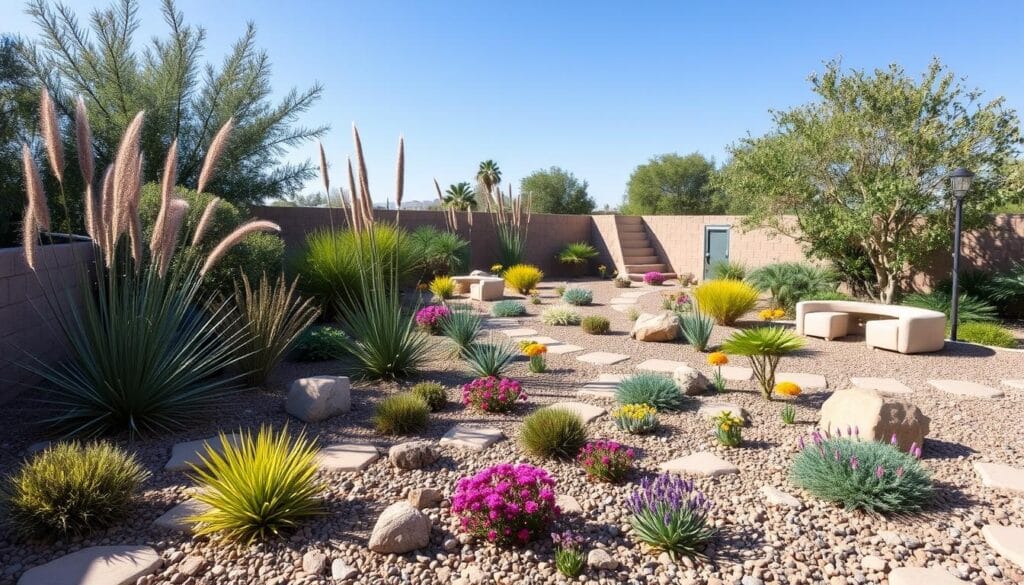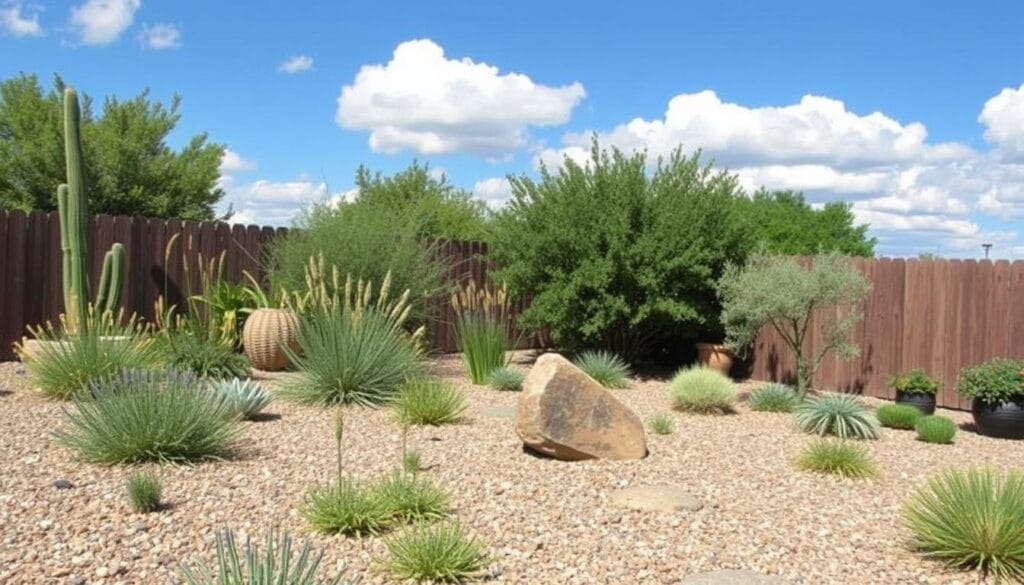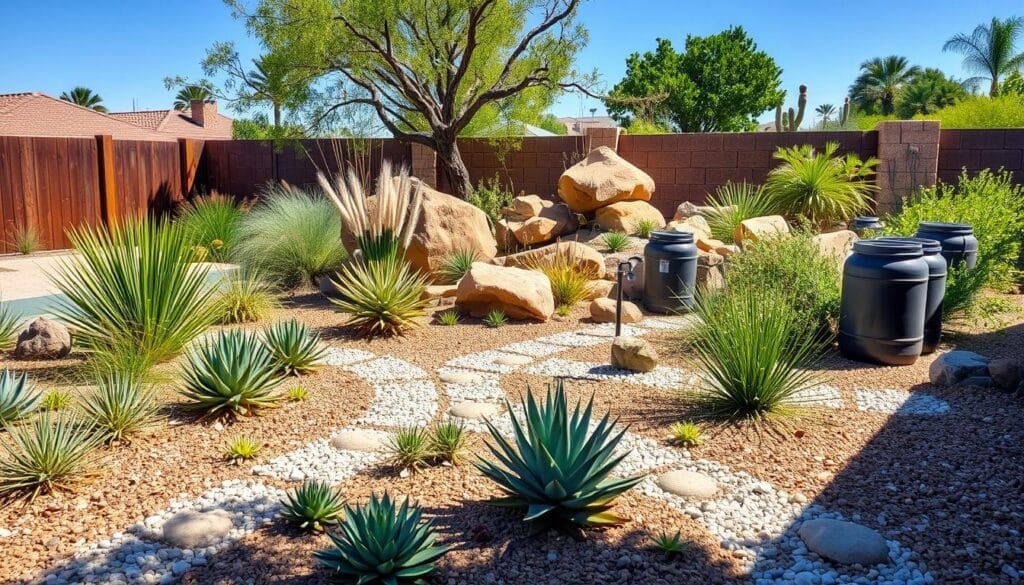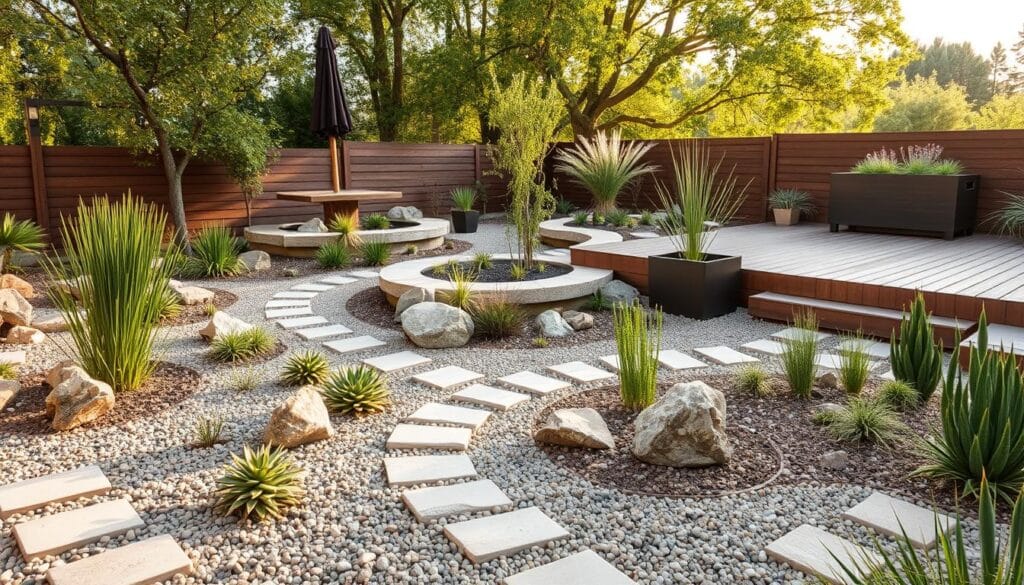Imagine having a beautiful outdoor space that brings you joy and relaxation without requiring a lot of time and effort to maintain. A low-maintenance garden design can offer you this. With well-planned easy-care landscaping, you can enjoy your garden without the hassle of frequent watering, pruning, and weeding. It’s perfect for homeowners who want to enjoy their outdoor space without spending too much time on upkeep.
A low-maintenance small garden design can give you a rewarding and relaxing outdoor retreat with less hassle and expense. By using compact perennials, long-lived shrubs, and drought-tolerant plants, you can create a stunning garden that requires minimal maintenance. Gravel gardens, naturalistic garden designs, and border gardens filled with low-maintenance perennials and shrubs are also great options to consider for your low-maintenance garden design.
By choosing the right plants and designing your garden with ease and efficiency in mind, you can create a beautiful and relaxing outdoor space that requires less maintenance. This will allow you to spend more time enjoying your garden and less time taking care of it. In this article, we will explore the essential tips for designing a low-maintenance garden, including easy-care landscaping ideas and strategies for reducing maintenance efforts.
Key Takeaways
- A well-planned low-maintenance garden design can save you time and effort in the long run.
- Incorporating compact perennials, long-lived shrubs, and drought-tolerant plants can reduce maintenance needs.
- Gravel gardens, naturalistic garden designs, and border gardens are great options for low-maintenance small garden designs.
- Easy-care landscaping ideas, such as mulching and using efficient irrigation systems, can also reduce maintenance efforts.
- By designing your garden with ease and efficiency in mind, you can create a beautiful and relaxing outdoor space that requires less maintenance.
- A low-maintenance garden design is perfect for homeowners who want to appreciate their outdoor space without dedicating too much time to its upkeep.
Understanding Low-Maintenance Gardening
If you’re a busy homeowner, you might not have much time for gardening. But, there are ways to enjoy your outdoor space without spending hours on upkeep. By using drought-tolerant plants and smart irrigation systems, you can have a beautiful garden that’s easy to care for.
For busy homeowners, garden design is all about keeping things simple. It’s about picking the right plants and designing your garden with ease in mind. For example, ground covers and vertical planters can make your garden look great while saving you time.
- Reduced water consumption
- Less need for fertilizers and pesticides
- Lower maintenance costs
- More free time to enjoy your outdoor space
By using low-maintenance gardening ideas, you can have a beautiful garden that’s easy to care for. This is perfect for busy homeowners who want to enjoy their garden without the hassle.
| Low-Maintenance Gardening Tips | Benefits |
|---|---|
| Use drought-tolerant plants | Reduced water consumption |
| Incorporate efficient irrigation systems | Lower water bills |
| Choose low-maintenance ground covers | Less need for pruning and weeding |
Choosing the Right Plants
When you’re setting up a low-maintenance garden, picking the right plants is key. You need plants that look good and don’t need much care. They should also do well with little water. This is perfect for people who don’t have a lot of time to tend to their garden.
Native plants, drought-resistant species, and perennials are great choices. Native plants fit right into your local climate and soil. Drought-resistant plants like succulents and cacti need very little water. Perennials, such as Black-eyed Susans and coneflowers, are tough and easy to care for.
Native Plants for Your Region
Native plants are a smart pick for your garden. They’re made for your local weather and soil. Here are a few examples:
- Diamond Collection Euphorbia
- Lemon Coral Sedum
- Supertunia Vista Jazzberry petunias
Drought-Resistant Species
For places with little rain, drought-resistant plants are the way to go. They can handle very little water. Here are a few:
- Denim ‘n Lace Perovskia
- Truffula Pink Globe Amaranth
- Shadowland ‘Coast to Coast’ Hosta

Perennials vs. Annuals
Perennials are tough and don’t need much care, making them great for easy gardens. Annuals, on the other hand, need to be replanted every year and might need more work. Here are some perennials:
- Prairie Winds ‘Cheyenne Sky’ Switch Grass
- Gem Box Ilex glabra
- Blue Chiffon Hibiscus syriacus
| Plant | Height | Spread | Bloom Time |
|---|---|---|---|
| Diamond Collection Euphorbia | 2-3 feet | 3-4 feet | Summer |
| Lemon Coral Sedum | 1-2 feet | 2-3 feet | Spring |
| Supertunia Vista Jazzberry petunias | 1-2 feet | 2-3 feet | Summer |
Designing for Efficiency and Ease
As a busy homeowner, you want your garden to be a peaceful spot that’s easy to care for. Simple garden design tips can make this happen. By using efficient design, you can have a beautiful and useful outdoor area that saves time and effort.
Think about making different zones in your garden for different activities. This could be a place to relax, a spot for growing veggies, or a play area for kids. This way, your garden is organized and easy to look after. Paths and easy-to-reach areas also help you move around without needing to water or prune too often.
Remember to use hardy plants like lavender and sedum to cut down on watering and upkeep. Mulch made from bark or leaves can also help keep weeds away and keep the soil moist. These steps help make your garden both easy to care for and lovely.
Other smart ideas include using raised beds, planting plants that help each other, and drip irrigation systems. These features make watering and care easier, making your garden a beautiful, low-maintenance space. By following these tips, you can enjoy a stunning garden without the stress of constant upkeep.
Soil Preparation and Fertilization
Soil preparation and fertilization are key for easy-care landscaping. You need well-draining soil rich in organic matter and the right pH for your plants. Choose the right soil and use organic composting to achieve this.
Choosing the right soil is crucial. Different plants need different soils. For example, succulents need well-draining soil, while hydrangeas need rich, slightly acidic soil.
Choosing the Right Soil Type
Soil types include clay, sandy, and loamy. Loamy soil is best for most plants. Clay soil can be hard to work with, while sandy soil needs frequent fertilization.
Organic Composting Techniques
Organic composting improves soil fertility and structure. It breaks down organic matter into a nutrient-rich soil amendment. This can be done in a compost bin or pile, reducing waste and creating natural fertilizer.
Composting benefits include better soil structure, increased fertility, and improved drainage. It also suppresses weeds and reduces synthetic fertilizer use. By composting, you can create a healthy, low-maintenance garden.

Follow these tips for a beautiful, easy-care landscape. Choose the right soil, and compost, and select plants that fit your climate and soil. With planning and effort, you’ll enjoy a stunning, low-maintenance garden for years.
| Soil Type | Characteristics | Benefits |
|---|---|---|
| Loamy Soil | Well-draining, rich in organic matter | Ideal for most plants, improves soil structure |
| Clay Soil | Prone to waterlogging, nutrient deficiencies | Can be challenging to work with, requires amendments |
| Sandy Soil | Requires frequent fertilization, which can be improved with compost | Requires frequent fertilization, can be improved with compost |
Irrigation Methods for Less Work
Low-water landscaping needs efficient irrigation methods. Drought-tolerant garden design focuses on saving water. Drip irrigation systems are a great choice because they water plants at the roots, cutting down on evaporation and runoff.
Drip irrigation systems save water, help plants grow better, and prevent soil erosion. For instance, the Metzerplas Dripline is efficient with a flow rate of 1.6 L/hr and a coil size of 100m. Raised garden beds with landscape fabric also help with weeding and pest control, making irrigation more efficient.
To set up a drip irrigation system, follow these steps:
- Choose drought-tolerant plants that need less water and care.
- Install a drip irrigation system, considering pipe size, filtration, and pressure.
- Use mulch to keep soil moist, control weeds, and regulate temperature.

By using these strategies, you can have a beautiful, low-maintenance garden. It will use less water and require less upkeep.
| Irrigation Method | Water Consumption | Maintenance Effort |
|---|---|---|
| Drip Irrigation | Low | Low |
| Traditional Sprinklers | High | High |
Hardscaping Elements to Consider
When designing a low-maintenance garden, think about hardscaping elements like patios, decks, and stone walkways. These add structure and beauty to your outdoor space. They also help keep maintenance low. By using these ideas, you can make a garden that looks great and is easy to care for.
Popular hardscaping materials include concrete, brick, and natural stone. They’re tough and can handle the weather, so you won’t need to fix or replace them often. For example, stone walkways are great for busy areas because they’re durable and easy to care for. Brick pathways are also durable and need little upkeep.
To design a low-maintenance garden, consider these hardscaping elements:
- Patios and decks: They offer a place to relax outside and cut down on lawn area. The lawn needs regular mowing and care.
- Stone walkways and borders: They make your garden look good and reduce the need for edging and weed control.
- Retaining walls: They’re useful and pretty, helping to stop erosion and making your garden look great.

Adding these hardscaping elements to your garden design makes it beautiful and easy to maintain. Choose materials and features that fit your budget and lifestyle. If you need help, talk to a professional designer for a low-maintenance landscaping plan.
| Hardscaping Element | Benefits | Maintenance Needs |
|---|---|---|
| Patios and Decks | Functional outdoor living space, reduced lawn area | Regular cleaning, occasional repairs |
| Stone Walkways and Borders | For functional and aesthetic purposes, erosion control | Occasional cleaning, minimal repairs |
| Retaining Walls | Functional and aesthetic purposes, erosion control | Regular inspections, occasional repairs |
Implementing Mulching Techniques
Mulching is key for easy-care landscaping. It helps reduce watering and weeding needs. This makes it great for low-maintenance garden plants. You’ll find many types of mulch, each with its benefits.
There are organic and inorganic mulches. Organic mulches like straw or wood chips improve soil over time. Inorganic mulches, like landscape fabric or stone, last longer but don’t break down. Choose based on your garden’s needs and plant types.
Types of Mulch: Organic vs. Inorganic
Popular organic mulches include:
- Straw: ideal for vegetable gardens and retaining moisture
- Wood chips: suitable for pathways and suppressing weeds
- Grass clippings: cost-effective and rich in nutrients
Inorganic mulches, like stone or rubber, are low-maintenance but don’t improve soil like organic mulches do.
Benefits of Mulching for Maintenance
Mulching boosts your garden’s health and looks. It fights weeds, keeps moisture, and controls soil temperature. Mulch also beautifies your garden, making it easy to care for.
When mulching, use 2-3 inches of mulch, a few inches from plant stems. The right mulch and care lead to a stunning, low-maintenance garden.
Seasonal Gardening Considerations
As a busy homeowner, you want to enjoy your outdoor space without spending too much time on maintenance. Low-maintenance landscaping ideas can help. It’s key to consider the changing needs of your garden throughout the year. This way, you can create a beautiful and thriving outdoor space that requires minimal upkeep.
When it comes to garden design for busy homeowners, seasonal variations are crucial. By choosing plants that can withstand long periods without water and tolerate heat, your garden will stay healthy and vibrant even in the hottest months. Native species, drought-tolerant flowers, and perennials that require minimal care are good examples.
Planting Schedules for Low Effort
To make the most of your garden, a planting schedule is essential. In early spring, clear debris, mulch, and divide perennials. By mid-spring, plant hardy, cool-season vegetables and add new plants. In late spring, clean up spent flowers, plant summer annuals, and transplant warm-season crops.
Seasonal Maintenance Tips
There are several seasonal maintenance tips to keep your garden looking its best. Monitor the weather and average frost dates, mulch early to prevent weed growth, and avoid pruning when plants are about to bloom. These tips help create a beautiful and thriving garden that requires minimal maintenance, perfect for busy homeowners.
- Watering plants deeply but infrequently to encourage deep root growth
- Using automated irrigation systems to save time and ensure proper watering
- Adding a layer of mulch to retain moisture and suppress weeds
- Dividing and replanting perennials in the fall to prepare for the next growing season
| Season | Planting Schedule | Maintenance Tips |
|---|---|---|
| Spring | Clear debris, mulch, divide perennials | Monitor weather, avoid pruning when plants are about to bloom |
| Summer | Plant summer annuals, transplant warm-season crops | Water deeply but infrequently, use automated irrigation systems |
| Fall | Divide and replant perennials, add mulch | Monitor frost dates, clean up spent flowers |
Wildlife and Pest Management
When designing your low-maintenance garden, think about wildlife and pest control. A smart garden can attract good bugs, cutting down on harmful chemicals. Drought-tolerant plants also mean less watering, which helps fight pests.
Some plants in a drought-tolerant garden naturally fight pests. Marigolds keep slugs and tomato worms away. Asters and goldenrod feed wasps, bees, and hummingbirds. These plants make your garden a welcoming place for beneficial insects.
Here are some tips for managing wildlife and pests in your garden:
- Use rain gardens to filter stormwater and prevent flooding. They help wildlife by providing water and food.
- Make a habitat garden with native plants. They need less water and care than non-native plants.
- Provide homes for local wildlife, like bat boxes and bird nests. This boosts biodiversity and pest control.
By following these tips, you can have a garden that’s easy to care for. It also helps local wildlife and keeps the ecosystem balanced. This fits with the goals of low-maintenance and drought-tolerant garden design, reducing the need for harmful chemicals.
A well-designed garden is good for the environment and local wildlife. Choose the right plants and use sustainable practices. This way, you’ll have a beautiful garden that’s easy to maintain and supports the local ecosystem.
| Beneficial Insects | Plants that Attract Them |
|---|---|
| Bees | Asters, Goldenrod, Marigolds |
| Butterflies | Native plants, such as Milkweed and Sunflowers |
| Ladybugs | Marigolds, Dill, and Fennel |
Creating a Maintenance Schedule
Creating a maintenance schedule is key to keeping your garden easy and fun for years. Start by finding simple garden design tips and low-maintenance landscaping ideas that fit your space and climate. This helps you set up a routine of important tasks that make care easier.
First, make seasonal checklists for your gardening tasks. Spring might mean adding organic mulch, pruning shrubs, and getting soil ready for new plants. Summer is for watching water needs and pulling weeds. Fall is for cleaning up leaves, dividing perennials, and planting bulbs for next year.
Winter is the time to check your garden’s health, make changes, and plan for the future. By sticking to a schedule that fits your garden’s needs, you can keep your garden looking great with little effort. Choose low-maintenance ideas that fit your lifestyle and enjoy a beautiful garden that’s easy to care for.
FAQ
What is low-maintenance garden design?
Low-maintenance garden design means creating spaces that are simple to care for. They need little time and effort to stay beautiful and healthy.
Why is low-maintenance gardening important in modern landscapes?
Today, people often have little time for their gardens. A low-maintenance garden lets homeowners enjoy their outdoor spaces without a lot of work.
What are the benefits of choosing low-maintenance garden plants?
Choosing plants that need less care, like native species, saves time. They also help with water conservation, making your garden more eco-friendly.
How can I design a garden for efficiency and ease of use?
Design your garden with easy-to-use zones and paths. This makes your garden more accessible and easier to maintain, perfect for busy people.
What role does soil preparation and fertilization play in low-maintenance gardening?
Good soil and composting help your garden grow well with less care. This reduces the need for frequent soil changes.
What are some low-maintenance irrigation options?
Using drip irrigation and smart watering saves water and time. These methods are key to a low-water garden.
How can hardscaping elements enhance a low-maintenance garden?
Adding features like patios and stone walkways makes your garden look great and easy to care for.
What are the benefits of using mulch in a low-maintenance garden?
Mulch keeps weeds away and holds moisture. It also cuts down on the need for frequent garden upkeep.
How do I plan for seasonal gardening in a low-maintenance landscape?
Plan your garden with seasonal tips. This way, busy homeowners can keep their garden thriving all year with little effort.
How can I manage wildlife and pests in a low-maintenance garden?
Attracting good bugs and using natural pest control helps keep your garden balanced. This approach avoids harsh chemicals and supports a healthy garden.
Source Links
- 11 Low-Maintenance Small Garden Design Ideas for Your Landscaping
- Top 20 Tips for Designing a Low-Maintenance Garden – Yanko Design
- How to Create a Low Maintenance Landscape
- Low Maintenance Garden Design
- 23 Best Low Maintenance Plants for Landscaping
- 25 Low-Maintenance Perennials for Every Garden – Garden Design
- Effortless Elegance: Low Maintenance Garden Bed Ideas to Revamp Your Outdoors – Bluestem Gardening
- 10 Low-Maintenance Front Yard Landscaping Ideas | Welcome to Better – M/I Homes
- Low-Maintenance Groundskeeping Strategies for Busy Campgrounds
- Low-maintenance landscaping ideas
- 13 Low-Maintenance Landscaping Ideas
- Dig in the Dirt! Soil Preparation: How Do You Prepare Garden Soil for Planting?
- How to Irrigate a Low Maintenance Garden – Irrigation Express
- How to Design a Low-Maintenance Garden by Eden Gardens
- Low Maintenance Landscaping: Easy and Beautiful Solutions
- Landscape and Hardscape Design: 5 Key Elements for 2024
- 7 low-maintenance landscaping ideas for retirees – Master Spas Blog
- 21 Best Hardscape Ideas for Your Outdoor Space
- Using Mulch in the Garden: A Comprehensive Guide
- 13 Best Mulch Garden Ideas For Your Home
- Using Mulch in Your Flower Garden (Simple Tips & Tricks) – Gingham Gardens
- Follow This Spring Garden Checklist for a Gorgeous Landscape All Year Long
- 27 Low-Maintenance Landscape Ideas for Your New Home
- Low Maintenance Garden Tips For All Landscapes | Mansfield
- Planning a Habitat Garden That Welcomes Wildlife
- 20 Sustainable Landscaping Ideas for an Eco-Friendly Home
- Creating a Low-Maintenance Garden
- The Ultimate Guide to Seasonal Landscape Maintenance
- DIY Vertical Planters: 7 Creative Hacks for Stunning Gardens


Pingback: 2024 Garden Design Trends for a Stunning Outdoor Escape